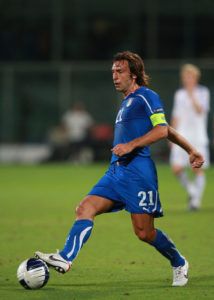and How Clubs are Using Attacking Midfielders As Solutions
There is a clear lack of equilibrium in the demand and supply of natural deep playmaking midfielders, the rapid progression of the 4-2-3-1 over the previous decade has seen a huge rise in the stock of a breed of midfielders who were thought to be dying. Indeed, it was one of the finest midfield orchestrators, Pep Guardiola, who in 2004, while managing Qatar FC, lamented about how his older role was not deemed unwanted in an age of revolving around the use of specific defensive midfielders and attacking midfielders:
“The emphasis, as far as central midfielders are concerned, is all on defensive work”
Yet, he did go on to mention one player who was continuing to shine the beacon of light, current Juventus player Andrea Pirlo. Pirlo has by far been the player looked up by many football experts as the greatest deep playmaker of his era but with little competition. That though has changed in recent times. Besides the usual suspects in Xavi and Xabi Alonso, two players who were groomed into the role at an early stage of their career, Xavi was seen as the direct replacement for Pep while Xabi was crucial to the Real Sociedad side of the early noughties which, amongst other impressive seasons, came second in the 2002/03 season thus leading to Xabi being awarded the Spanish Player of the year, the increasing preference of the 4-2-3-1 for many European sides has seen the growth of players occupying the deep playmaker position.
The rapid increase of the formation (and its close cousins, the 4-3-3 and 4-1-4-1) over the last 3-4 years has caused a boom in the demand for teams to concentrate more on dominating the center of the pitch. With that tactic comes the need for players who are able to be efficient in possession of the ball. The above graph shows the percentages of matches, for the English Premier League, that the team has opted to play a 5 man midfield with a lone striker (either 4-2-3-1, 4-3-3 or 4-1-4-1). Though not always, the five man midfield, and 3 man central midfield, involves a deep lying playmaker (also used in some 4-4-2s as with the Manchester United’s case) who is used to effectively control possession and dictate play for his team. Therefore, we can see that there is a huge demand for players with the qualities required to play that role.
The demand has thus far not been easy to keep up with; logically since most of the younger players coming up today have been groomed according to the prevailing tactics of the time, mostly either has attacking midfielders or as defensive midfielders. Two players have been immediate success though through the adaption from an attacking midfielder to deep playmaker are Luka Modric and Bastian Schweinsteiger and thus still being relatively young in comparison to Xavi and Xabi Alonso, their price is arguably amongst the top 5 in the world. Chelsea did have a 40 Million Pounds bid rejected by Tottenham just last August. It’s not only Chelsea who are suffering from the lack of quality playmakers, many of Europe’s top clubs are looking for players to take over the role and many are resorting to testing attacking midfielders in that position.
What is a Deep Playmaker?:
First things first, one has to get the definition of the deep playmaker out of the way. The position is in the center of midfield and can be adopted within either the more common 4-2-3-1 or the 4-4-2 (4-2-2-2 for the pedantic). The formation matters less but what is essential is the qualities of the player, quite specific to certain areas, more than any other position in midfield.
The main qualities one would be looking for within a deep playmaker are passing, intelligence and defensive positioning. His role is that of the main distributor, a quarter back if you will, who provides a link between the defence and the attack and usually connects them with one wonder pass of the ball. Passing, therefore, is considered to be, rather with dire consequences it must be said, the single most important asset needed for a deep playmaker and therefore we can somewhat already see the reasoning behind the articles main argument of attacking midfielders being player deeper than they are used to.
Now, I will try to show some examples of teams opting to rotate attacking midfielders into deeper positions in order to fulfill the need of the playmaker and also the defensive problems that can arise from such tactics.
Being a Manchester United fan, the recent trouble presenting itself in the center of midfield has been a particularly interesting issue to study. The question for years has always been regarding the successor to Paul Scholes, one of the most complete central midfielders of his era, starting off as a striker and slowly ending his career as a deep playmaker when his legs weren’t able to carry him forward like they used to. Michael Carrick and Paul Scholes presented a formidable central midfield partnership, though both played very similar roles and were key players in Manchester United’s successes in the mid noughties. What is also interesting though are the players being linked to United daily in hope of solving thosethat lingering question. Besides Luka Modric no other Premier League player consistently linked could be classified as a deep playmaker like Scholes in his latter career, and that is the inherent problem that manager Sir Alex Ferguson is having to work around. Tottenham well and truly know the value of Luka not only to United but also to the other big teams of the Premier League. While his quality is an indication of the value, the lack of substitutes almost doubles that value.
Manchester United are not the financial power they used to be, bidding over the 40 million Tottenham have been demanded is far out of the reach of the Red Devils so they were forced to look elsewhere. Bastian Schweinsteiger was another name commonly put in the press and eventhough his contract was running out within two years and there were slight concerns that he might not accept Bayern Munich’s latest contract offer, the German club were reportedly not going to budge unless offers were in the ludicrous numbers. As it happened, Schweinsteiger did sign a new contract thereby rendering him completely off the market.
So those were the two established deep playmakers gone from the reckoning. Surely there were other players natural to that position who were available? That was simply not the case, the next target that United were set on was Inter Milan’s Wesley Sneijder, a player who had played his entire career as an attacking midfielder, playing either center or on either sides. There was much discussion about just how Sneijder, who had come off his best season in 2009-10 playing as an attacking midfielder in Jose Mourinho’s Inter Milan side that won the Seria A and Champions League, would fit in a United system, that while not technically having an attacking midfield position on the team sheet, with Rooney occupying his usual role. Comparing two usual performances of Wesley Sneijder and Wayne Rooney shows the similarities in the positions occupied by both players.
A heat map of the man Wesley Sneijder is trying to replace, Paul Scholes, shows how Sneijder would have to adapt his game in order to fill the role required of him
.
The heat map shows a clear preference to stay behind the half way line in support of the defenders rather than the attackers. For Inter Milan during Mourinho’s days, this role was rotated amongst Esteban Cambiasso and Thiaggo Motta though neither were very adept at passing long range, rather sticking to the role of winning the ball in midfield and laying it off with short and simple passes to Sneijder in attacking positions. Sneijder essentially had two very adept defensive players in behind him thereby reducing the responsibilities on him to support his defenders, he will not be given the same license while at United and would have to learn the trades of defending if he were to be successfully implemented in that position.
It should be added that while United did fail to bring in a new star midfielder, they potentially found one in one of their own, Tom Cleverley. Manchester United were playing like a team possessed in the early part of the season and a primary reason for that was the form of Cleverley who was playing the role of the conductor in midfield, alongside Anderson. While United were free flowing in attack, they were also porous in terms of conceding shots on goal. During the first four games in which Tom Cleverley and Anderson were partnering in midfield, United conceded 7goals in the first four matches, after which Cleverley’s injury has ruled them out for the rest of the season till date. That in effect is the possible danger United are facing if they bring in Wesley Sneijder.
Part 2 will up very soon










Recent Comments